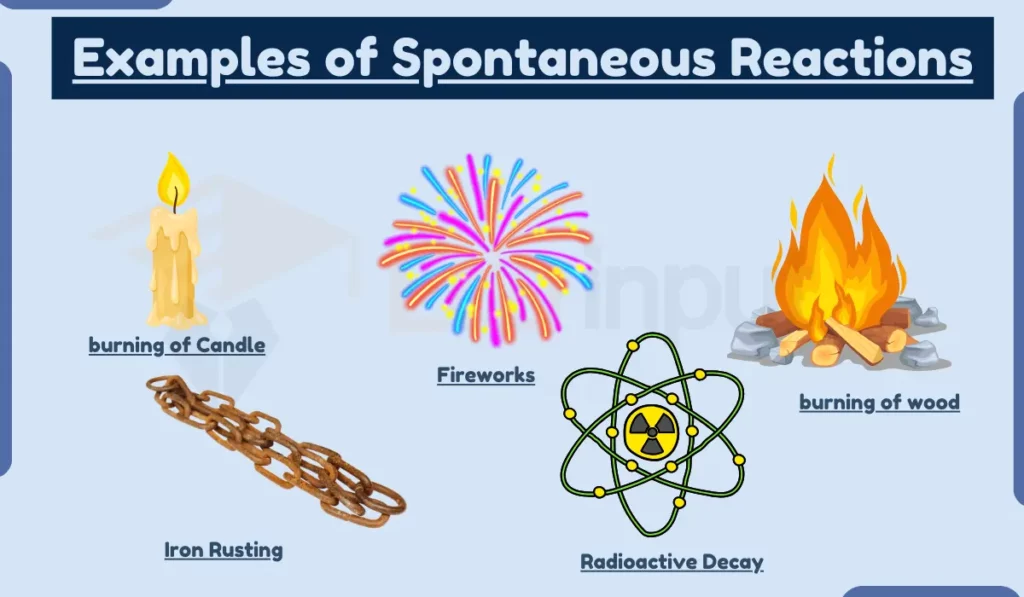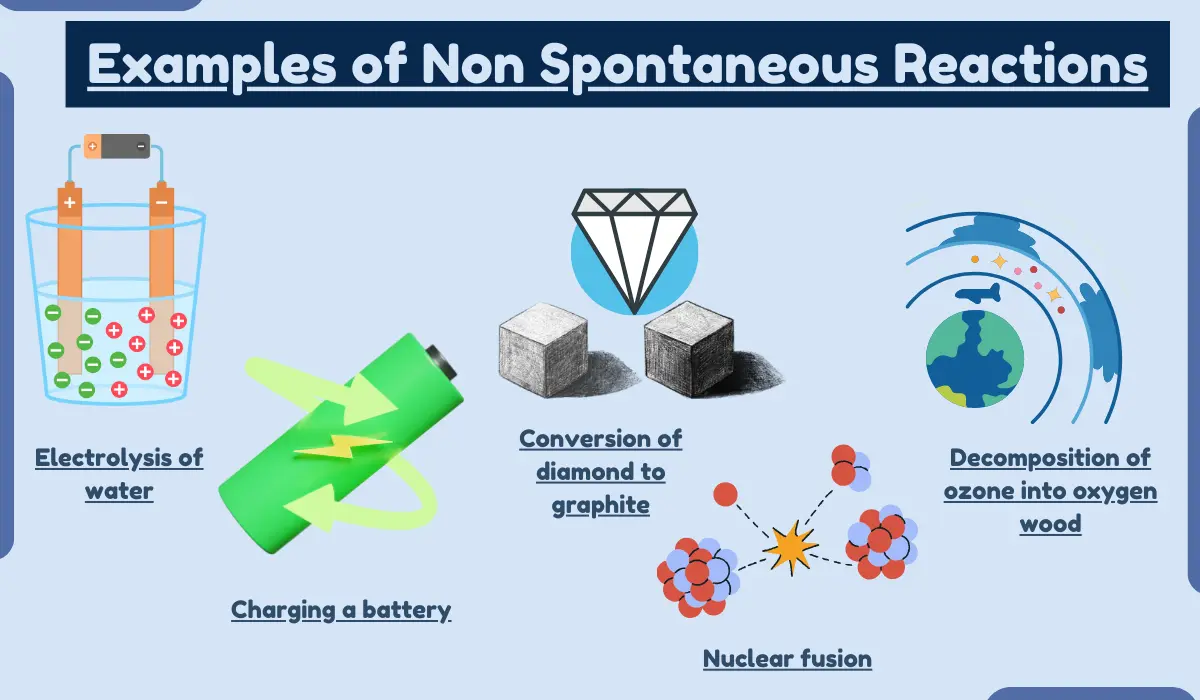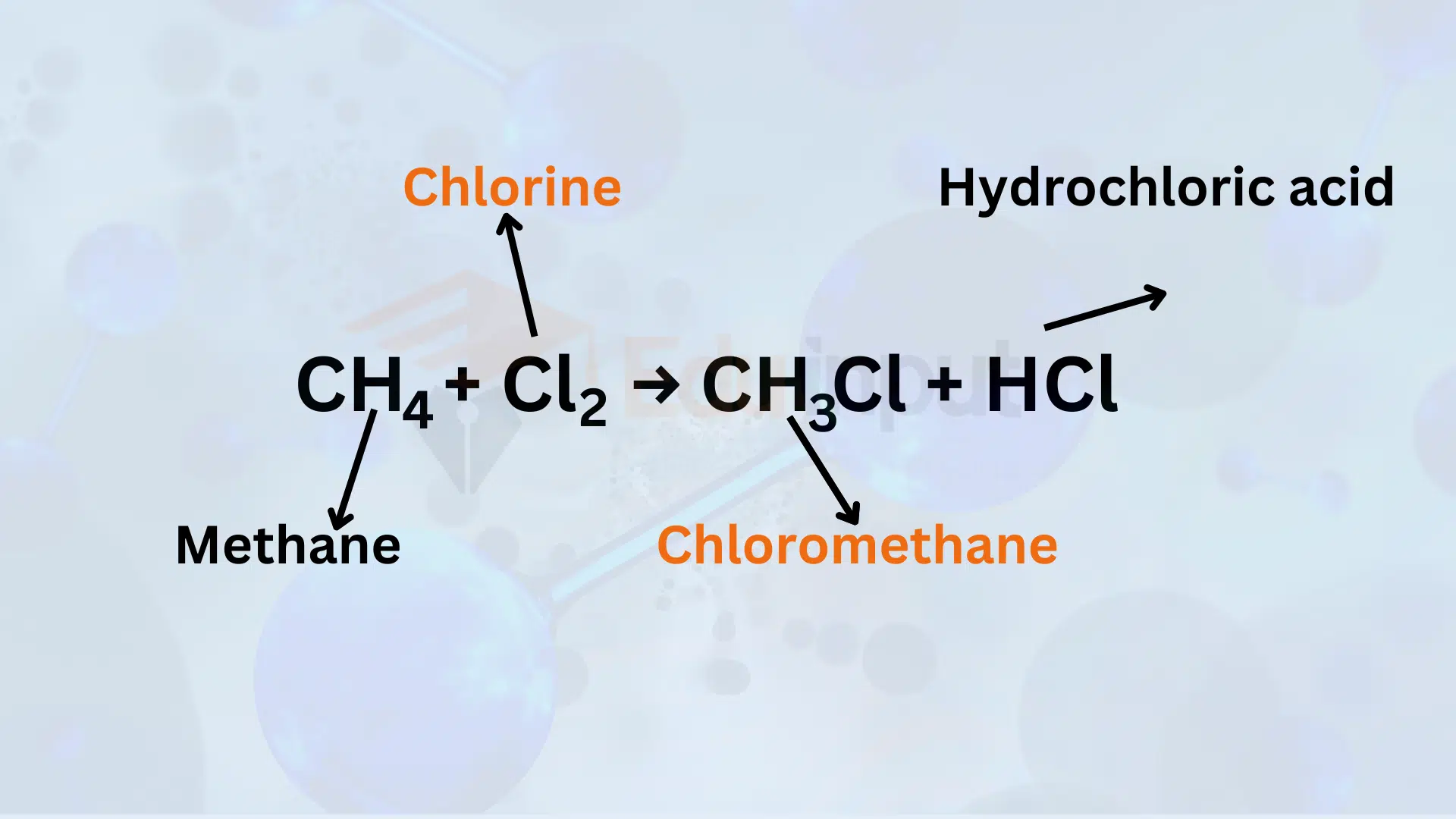10 Examples of Spontaneous Reactions
The burning of wood, the explosion of fireworks, burning candle, Combustion, rusting, and the ripening of fruits are all examples of spontaneous reactions.

Also read: Examples of Non Spontaneous Reactions
Examples of Spontaneous Reactions
Here are a few Examples of Spontaneous Reactions:
1: Burning of wood
The burning of wood is a spontaneous reaction because it is Exothermic, meaning that it releases heat to the surroundings. This heat release lowers the Gibbs free energy of the system, making the reaction favorable.
Additionally, the burning of wood produces carbon dioxide and water, which are more stable compounds than wood and oxygen.
Equation: C(s) + O2(g) —> CO2(g) + H2O(g) + heat
Also read about Endothermic reactions
2: Rusting of iron
The rusting of iron is a spontaneous reaction because it is also exothermic and produces more stable compounds. Rust is a form of iron oxide, which is more stable than iron and oxygen.
Equation: Fe(s) + O2(g) -> Fe2O3(s)
3: Neutralization of acids and bases
The neutralization of acids and bases is a spontaneous reaction because it produces more stable compounds. Salts and water are more stable than acids and bases because they have a lower potential energy.
Equation: HCl(aq) + NaOH(aq) -> NaCl(aq) + H2O(l)
4: Precipitation reactions
Precipitation reactions are spontaneous because they produce insoluble products. Insoluble products are more stable than soluble products because they have a lower potential energy.
Equation: AgNO3(aq) + NaCl(aq) -> AgCl(s) + NaNO3(aq)
5: Dissolving of ionic salts in water
The dissolving of ionic salts in water is a spontaneous reaction because it produces hydrated ions. Hydrated ions are more stable than solid salts because they have a lower potential energy.
Equation: NaCl(s) -> Na+(aq) + Cl-(aq)
6: Thermal decomposition of unstable compounds
The thermal decomposition of unstable compounds is a spontaneous reaction because it produces more stable products. Unstable compounds have a high potential energy, so they are more likely to decompose into more stable compounds with a lower potential energy.
Equation: 2H2O2(l) -> 2H2O(l) + O2(g)
7: Decomposition of organic matter by bacteria
The decomposition of organic matter by bacteria is a spontaneous reaction because it releases energy and nutrients that the bacteria need to survive. Bacteria use the energy released from the decomposition of organic matter to grow and reproduce.
Equation: C6H12O6(s) + 6O2(g) -> 6CO2(g) + 6H2O(l)
8: Diffusion of gases
The diffusion of gases is a spontaneous reaction because it increases the entropy of the system. Entropy is a measure of the disorder of a system. When gases diffuse, they spread out and become more disordered, which increases the entropy of the system.
Equation: NO2(g) + CO(g) -> NO(g) + CO2(g)
9: Osmosis
Osmosis is a spontaneous reaction because it equalizes the concentration of water on both sides of a semipermeable membrane. Semipermeable membranes allow water molecules to pass through, but not other molecules.
When there is a difference in water concentration on either side of a semipermeable membrane, water will flow from the side with the higher concentration to the side with the lower concentration. This flow of water equalizes the concentration of water on both sides of the membrane.
Equation: H2O(pure) -> H2O(solution)
10: Radioactive decay
Radioactive decay is a spontaneous reaction because it forms more stable isotopes. Isotopes are atoms of the same element with different numbers of neutrons. Radioactive isotopes are unstable because they have too many or too few neutrons. When radioactive isotopes decay, they lose or gain neutrons to become more stable isotopes.
Equation: 238U -> 206Pb + 8 He + 6 neutrons
Also Read: Difference between Spontaneous and Non-Spontaneous Reactions
Difference Between Endothermic And Exothermic Reactions





Leave a Reply